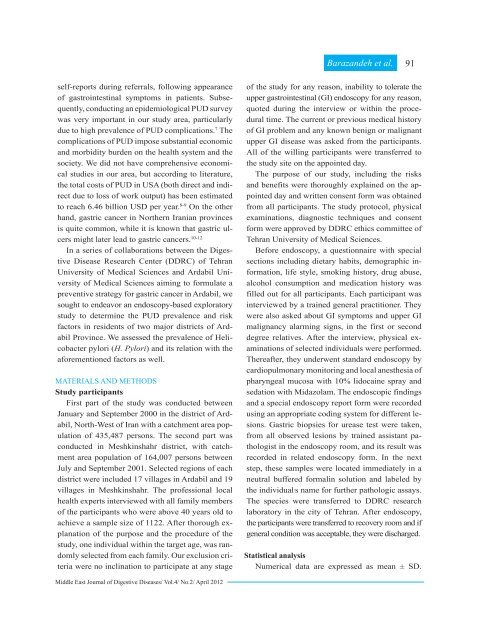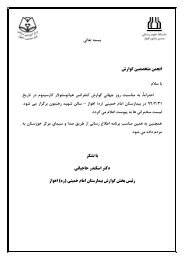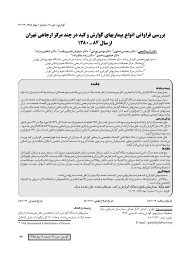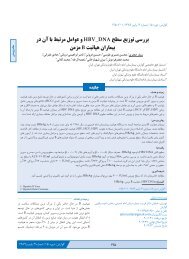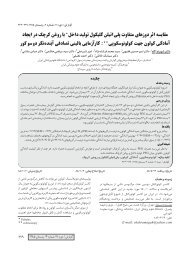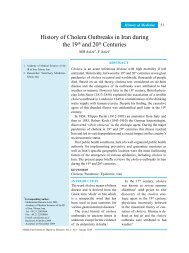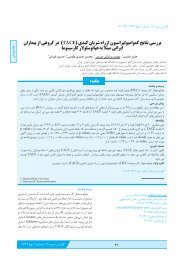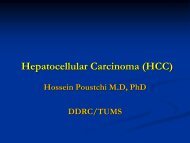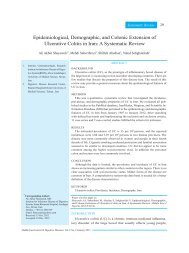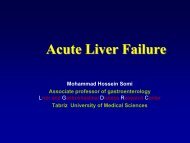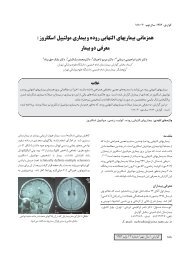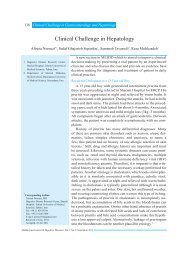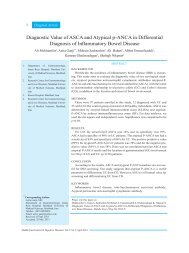Epidemiology of Peptic Ulcer Disease: Endoscopic Results of ... - IAGH
Epidemiology of Peptic Ulcer Disease: Endoscopic Results of ... - IAGH
Epidemiology of Peptic Ulcer Disease: Endoscopic Results of ... - IAGH
Create successful ePaper yourself
Turn your PDF publications into a flip-book with our unique Google optimized e-Paper software.
Barazandeh et al. 91<br />
self-reports during referrals, following appearance<br />
<strong>of</strong> gastrointestinal symptoms in patients. Subsequently,<br />
conducting an epidemiological PUD survey<br />
was very important in our study area, particularly<br />
due to high prevalence <strong>of</strong> PUD complications. 7 The<br />
complications <strong>of</strong> PUD impose substantial economic<br />
and morbidity burden on the health system and the<br />
society. We did not have comprehensive economical<br />
studies in our area, but according to literature,<br />
the total costs <strong>of</strong> PUD in USA (both direct and indirect<br />
due to loss <strong>of</strong> work output) has been estimated<br />
to reach 6.46 billion USD per year. 8-9 On the other<br />
hand, gastric cancer in Northern Iranian provinces<br />
is quite common, while it is known that gastric ulcers<br />
might later lead to gastric cancers. 10-12<br />
In a series <strong>of</strong> collaborations between the Digestive<br />
<strong>Disease</strong> Research Center (DDRC) <strong>of</strong> Tehran<br />
University <strong>of</strong> Medical Sciences and Ardabil University<br />
<strong>of</strong> Medical Sciences aiming to formulate a<br />
preventive strategy for gastric cancer in Ardabil, we<br />
sought to endeavor an endoscopy-based exploratory<br />
study to determine the PUD prevalence and risk<br />
factors in residents <strong>of</strong> two major districts <strong>of</strong> Ardabil<br />
Province. We assessed the prevalence <strong>of</strong> Helicobacter<br />
pylori (H. Pylori) and its relation with the<br />
aforementioned factors as well.<br />
MATERIALS AND METHODS<br />
Study participants<br />
First part <strong>of</strong> the study was conducted between<br />
January and September 2000 in the district <strong>of</strong> Ardabil,<br />
North-West <strong>of</strong> Iran with a catchment area population<br />
<strong>of</strong> 435,487 persons. The second part was<br />
conducted in Meshkinshahr district, with catchment<br />
area population <strong>of</strong> 164,007 persons between<br />
July and September 2001. Selected regions <strong>of</strong> each<br />
district were included 17 villages in Ardabil and 19<br />
villages in Meshkinshahr. The pr<strong>of</strong>essional local<br />
health experts interviewed with all family members<br />
<strong>of</strong> the participants who were above 40 years old to<br />
achieve a sample size <strong>of</strong> 1122. After thorough explanation<br />
<strong>of</strong> the purpose and the procedure <strong>of</strong> the<br />
study, one individual within the target age, was randomly<br />
selected from each family. Our exclusion criteria<br />
were no inclination to participate at any stage<br />
<strong>of</strong> the study for any reason, inability to tolerate the<br />
upper gastrointestinal (GI) endoscopy for any reason,<br />
quoted during the interview or within the procedural<br />
time. The current or previous medical history<br />
<strong>of</strong> GI problem and any known benign or malignant<br />
upper GI disease was asked from the participants.<br />
All <strong>of</strong> the willing participants were transferred to<br />
the study site on the appointed day.<br />
The purpose <strong>of</strong> our study, including the risks<br />
and benefits were thoroughly explained on the appointed<br />
day and written consent form was obtained<br />
from all participants. The study protocol, physical<br />
examinations, diagnostic techniques and consent<br />
form were approved by DDRC ethics committee <strong>of</strong><br />
Tehran University <strong>of</strong> Medical Sciences.<br />
Before endoscopy, a questionnaire with special<br />
sections including dietary habits, demographic information,<br />
life style, smoking history, drug abuse,<br />
alcohol consumption and medication history was<br />
filled out for all participants. Each participant was<br />
interviewed by a trained general practitioner. They<br />
were also asked about GI symptoms and upper GI<br />
malignancy alarming signs, in the first or second<br />
degree relatives. After the interview, physical examinations<br />
<strong>of</strong> selected individuals were performed.<br />
Thereafter, they underwent standard endoscopy by<br />
cardiopulmonary monitoring and local anesthesia <strong>of</strong><br />
pharyngeal mucosa with 10% lidocaine spray and<br />
sedation with Midazolam. The endoscopic findings<br />
and a special endoscopy report form were recorded<br />
using an appropriate coding system for different lesions.<br />
Gastric biopsies for urease test were taken,<br />
from all observed lesions by trained assistant pathologist<br />
in the endoscopy room, and its result was<br />
recorded in related endoscopy form. In the next<br />
step, these samples were located immediately in a<br />
neutral buffered formalin solution and labeled by<br />
the individual , s name for further pathologic assays.<br />
The species were transferred to DDRC research<br />
laboratory in the city <strong>of</strong> Tehran. After endoscopy,<br />
the participants were transferred to recovery room and if<br />
general condition was acceptable, they were discharged.<br />
Statistical analysis<br />
Numerical data are expressed as mean ± SD.<br />
Middle East Journal <strong>of</strong> Digestive <strong>Disease</strong>s/ Vol.4/ No.2/ April 2012


